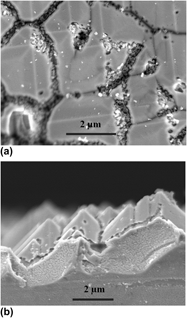Article contents
Self-patterned localized metal contacts for silicon solar cells
Published online by Cambridge University Press: 23 July 2013
Abstract

This paper describes the use of self-patterning anodic aluminum oxide (AAO) layers to enable localized metal contacts and to achieve passivation for the rear surface of silicon solar cells. There are no commercially available technologies that are capable of patterning localized contacts on silicon solar cells with low cost, high-throughput, and robust processing, especially when closely spaced small-area openings are required. In the approach described, nanoporous AAO layers were formed by anodizing aluminum over intervening dielectrics on textured silicon wafers. When the anodized test structures were fired in a belt furnace, localized contacts formed at peaks and valleys of the alkaline-textured silicon surface. Furthermore, the anodization contributed ∼35 mV increment in the implied Voc of the test structures. Low contact resistivity was demonstrated and the proposed contacting mechanism for this innovative localization suggested that the contact percentage can be controlled by varying the anodization duration and/or the surface morphology.
- Type
- Invited Feature Paper
- Information
- Copyright
- Copyright © Materials Research Society 2013
References
REFERENCES
- 11
- Cited by




